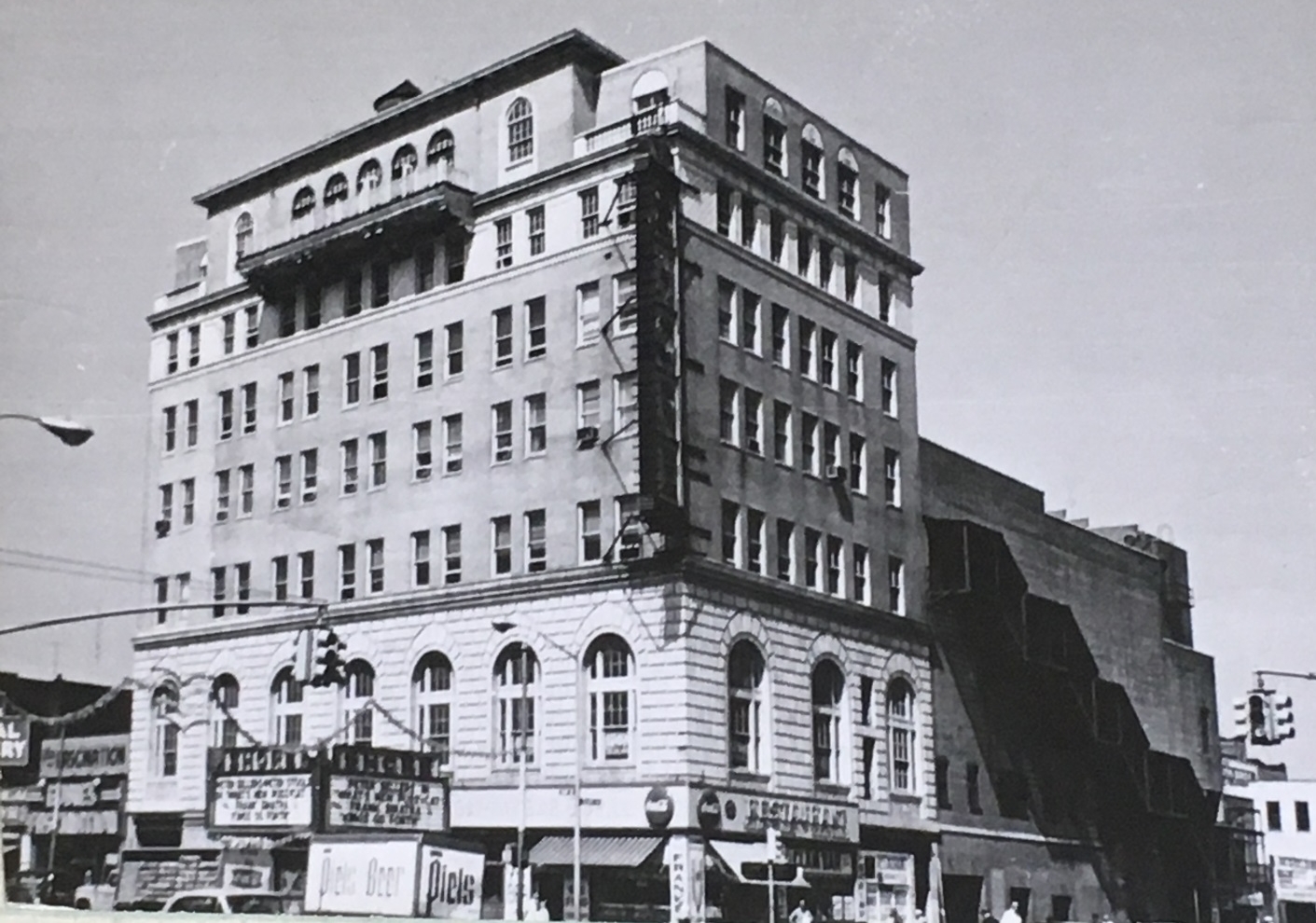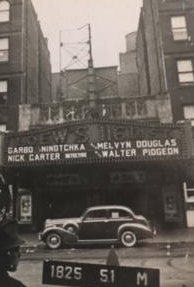Modern movie theaters are so pedestrian you might not be aware of their more fantastic history. Many of the most spectacular of these “movie palaces” were built by New York City businessman Marcus Loew. From the early 1900s through the 1930s he financed and constructed several architecturally interesting and historically important movie theaters throughout the five boroughs. Designed by prominent architects, these buildings served both as theaters for film viewing as well as event venues featuring live shows and performances. But, beginning in the 1950s, many of these stupendous theaters were sold, converted to entirely different purposes, demolished, or simply abandoned. Recently, several have been restored to their former glory. And thanks to the Department of Finance tax photo collection, one can watch the evolution of these buildings.
In the 1900s, New Yorker Marcus Loew started converting storefronts to nickelodeon's (theaters operated by inserting a nickel)—usually just small spaces set up for viewing early short films. By 1907, he had a chain of 3,000 nickelodeons. With the advent of longer “feature” motion picture films, the nickelodeons became obsolete, replaced by purpose-built movie theaters. Loew jumped on the trend and began building movie theaters all over the five boroughs. The first Loew’s Theater in New York City was erected in Brooklyn on Willoughby and Pearl Streets. In 1914 he constructed the Loew’s Bedford movie theater at 1372 Bedford Avenue in the Bedford Stuyvesant neighborhood of Brooklyn. Designed by famed-theater architect Thomas L. Lamb, in the Renaissance Revival style, it is still standing today, currently known as the Washington Temple, Church of God.
Loew’s Bedford in the 1940s.
The marquee advertises the movie,“Doctor Takes a Wife.”
The Loew’s Bedford hosted fashion shows, vaudeville, and movies. The Loew’s Bedford was purchased by the Reverend F.D. Washington in 1951. The theater was a perfect fit for a church, given its ample seating and flamboyant exterior. A large cross replaced the marquee. Future civil rights activist, Al Sharpton would go on to give his first sermon and become ordained as a Pentecostal minister at this church at age four. The Washington Temple continues as a thriving congregation to this day.
Another Loew’s Theater that thrived in from the 1930s until the 1950s was the Loew’s 116, located at 132 West 116th Street in Harlem. This Loew’s Theater, while less extravagant than the Loew’s Bedford, was still a very popular spot. In 1956, the theater held a contest of “Miss Exquisite Form,” featuring prizes over $10,000 and Burt Lancaster as a celebrity judge. This theater also advertised and boasted its new air conditioning system in 1958, which was seen as the answer to Harlem’s heat wave. However, even air conditioning could not save the theater. It eventually closed and was purchased by Canaan Baptist Church of Christ in the late 1950s, which opened for services in the 1960s.
Converted from a Loews theater, Harlem’s Canaan Baptist Church of Christ has a famous history. In the late 1960’s, Wyatt Tee Walker, former chief of staff to Dr. Martin Luther King, Jr., became the pastor of the church. Pastor Walker invited major civil rights figures to speak at the church, including South African Archbishop Desmond Tutu, Reverend Jesse Jackson, as well as Dr. King. In October of 1994, newly elected president of South Africa, Nelson Mandela made a stop at this church on his tour of the United States.
Today, the congregation continues to participate in civil rights activism, and tourists from all over the world come to visit the historic church.
A view of the back of the church in this 1980s tax photos reveals the infrastructures of a movie theater.
Occupied by church communities, these two buildings survived intact past their tenure as Loew’s theaters. However, not all Loew’s theaters have been as lucky. The Loew’s Coney Island Theater, which opened in 1925, was larger than the Loew’s Bedford and Loew’s 116. It was not the largest—that honor goes to the Loew’s King Theater, located in the Flatbush neighborhood of Brooklyn.
Coney Island in the 1920s was the most over the top place a person could visit in Brooklyn. Reflecting this, the Loew’s Coney Island was designed in the Neo Classical style with an interior painted in gold and had seating for over 2,600 people. Its opening day was as extravagant as the decor, with shows featuring the famous Siamese twins Violet and Daisy Hilton. Sadly, despite its nearly 40-year run, this theater did not survive the decline of the movie palace in the 1960s.


In 1964, the owners of Loew’s Coney Island Theater lost their lease and soon the theater deteriorated, eventually becoming a porn theater and then a bingo hall in the 1970s. It finally closed in 1973. In 1979, it was purchased by Horace Bullard who operated a chain of Kansas Fried Chicken (named after Max’s Kansas City, a famous nightclub in New York). In 2010, the theater was designated as a city landmark, requiring that any future plans for restoration be approved by the City Landmarks Preservation Commission. While the outside of the theater must remain intact, the inside can be altered or demolished.
The Loew’s Coney Island in the 1980s housed a Kansas Fried Chicken, a chain owned by Horace Bullard who bought the Shore Theater for $125,000 in 1979.
In 2016, Horace Bullard’s daughter finally sold the building to Pye Properties for $14 million. Future plans for this once opulent building have not been made public.
The Loew's King Theater in Flatbush is an example of the possibilities these theatre buildings hold. The Loew’s King Theater was renovated and transformed into an operating wonder theater once again. Serving as a major concert venue, it is now the largest theater in Brooklyn, and the third largest in New York City. Diana Ross performed at the reopening in 2015.
Thanks to the Department of Finance tax photos from the 1940s and 1980s, we can see how these movie theaters have evolved from their heyday in the 1940s to a variety of adaptive re-uses and even a full restoration to the original grand theater it once was—the Loew’s King Theater being the best example. If you’re interested in learning more about the history of any building in New York City, please visit our online gallery, the 1940s images are not currently available but they will be digitized and made available in the near future.
Citations and Further Reading
Author, Art. "Ten More Winners of Eagle Personality Poll Preliminaries are Picked." Brooklyn Daily Eagle, 30 Apr. 1936, p. 9.
http://www.brooklyneagle.com/articles/2017/5/10/were-waiting-makeover-coney-islands-shore-theater
http://www.brooklynpaper.com/stories/35/31/bn_zigunaddress_2012_08_03_bk.html
http://www.brownstoner.com/history/kings-theatre-brooklyn-restoration-history/
http://www.cbccnyc.org/history2.html
http://cinematreasures.org/theaters/2237
http://www.huffingtonpost.com/2012/08/03/shore-theater-coney-island-photographer-matt-lambros-photos_n_1738150.html
"F. D. Washington Named Bishop." The New York Age, 1 January 1955, p 1.
Landmarks Preservation Commission, December 14, 2010, Designation List 436, LP-2408
“Loews 116 gets cool Plant .” The New York Age , 12 July 1958, p. 23.
“Loew's Latest.” The Brooklyn Daily Eagle, 14 June 1925, p. 2E.
"Loew Theatres all set for 30th Anniversary." The Brooklyn Daily Eagle, 8 January 1934, p 6.
“Minister's son awarded $500 for discrimination against Loew's theatre .” The New York Age , 28 May 1927, p. 3.
http://www.nyc-architecture.com
Spellen, Suzanne. “Building of the Day: 1372 Bedford Avenue.” Http://Www.brownstoner.com, 25 May 2010, www.brownstoner.com/architecture/building-of-the-19/. Accessed 20 Aug. 2017.
Yarrow, Andrew L. "Movie Theaters: Facts and Figures." The New York Times, 6 June 1987.







